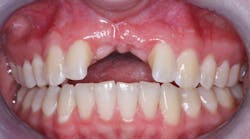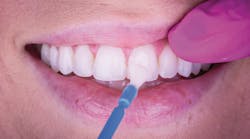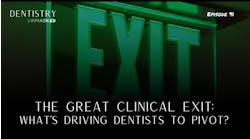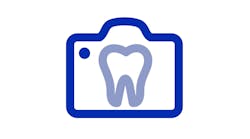The positive and negative effects of fluoride use on dental implants
Fluoride is used to prevent microbial infection and caries formation. It can be found in toothpaste, topical applications, varnishes, mouth rinses, and glass ionomer cement. However, fluoride ions are known to be corrosive to titanium.1
The corrosive properties of fluoride can enhance dental implant surface characteristics. The process involves modifying the implant surface to increase its roughness and surface energy, which aids in better bone integration. This method involves immersing dental implants in a fluoride-containing solution, typically hydrofluoric acid, through an electrochemical process where the implant acts as the cathode in an electrochemical cell.
Fluoride ions interact with the implant's titanium surface, creating a fluoride layer. This layer increases the surface energy and creates a more hydrophilic surface of the implant, promoting better cellular attachment and proliferation.2,3 This advancing science benefits the surgical placement of the implant surface texture, leading to faster osseointegration and more predictable results.
Comparing fluoride treatment to other surface treatments for dental implants can help highlight the unique benefits and limitations of fluoride. Other dental implant surface treatments include:
Sandblasting and acid etching: This involves blasting the implant surface with abrasive particles and then etching it with acid. This creates a rough surface that enhances bone cell attachment and osseointegration. While effective, it doesn't offer the same antimicrobial properties as fluoride treatment.4
Plasma spraying: A plasma spray coats the implant with a layer of titanium or hydroxyapatite, increasing surface roughness and biocompatibility. The plasma provides excellent osseointegration but can be more complex and costly compared to fluoride treatment.5
Anodization: This uses an electrochemical process to create a porous oxide layer on the implant surface. This method enhances surface roughness and promotes better bone integration. It's similar to fluoride treatment in promoting osseointegration, but fluoride treatment may offer better antibacterial properties.6
Laser treatment: This uses laser technology to create micro- and nano-scale surface textures, giving precise control over surface topography and improved cell response. Laser treatment can be more expensive and technically demanding, whereas fluoride treatment is more straighforward and cost-effective.7
Hydroxyapatite coating: This method applies a layer of hydroxyapatite, a naturally occurring mineral in bone, onto the implant. It offers excellent biocompatibility and promotes bone growth.4
Each of these treatments has advantages and may be chosen based on specific clinical needs for osseointegration. Fluoride stands out for its simplicity, cost-effectiveness, and added antibacterial benefits. The use of fluoride on titanium modifies the implant’s surface texture to enhance the interaction between the implant’s surface and its surrounding bone, which will facilitate osseointegration while minimizing bacterial colonization to reduce the risk of biofilm formation.8
Fluoride benefits at placement versus long-term maintenance
We must focus on the difference in fluoride’s effect between the manufacturing of the dental implant for osseointegration during surgical placement and the effects that result from the use of topical fluoride on patients with mixed dentition of dental implants, natural teeth, and high caries rate.
Use of topical fluoride
Fluoride has been used to improve oral health because of its activity in protecting dental hard tissue and its antimicrobial properties. However, the impact of incorporating topical fluoride on patients with titanium implants is still not fully understood. We must focus on the common practice of using fluoride to prevent caries in patients with a mixed dentition of titanium implants and natural teeth with a high caries rate.
Fluoride benefits patients with mixed dentition and a high caries rate to maintain oral health, preventing caries on the remaining natural teeth. Dental hygienists and dentists prescribe higher fluoride concentrate dosages for those at a high risk of the disease.9 Besides stannous fluoride’s antibacterial benefits, fluoride application after implant placement will not benefit titanium implants after initial osteointegration.
Fluoride antibacterial benefits
One benefit of the topical application of fluoride in implant dentistry is that modification can also enhance the implant’s resistance to bacterial colonization, reducing the risk of biofilm formation.10 The presence of fluoride on the titanium implant surface may facilitate the structural disruption and detachment of biofilm.11 Fluoride is known to exert antimicrobial modes of action against S. mutans, preventing its enrichment by directly inhibiting critical metabolic processes and by indirectly reducing environmental acidification in biofilms.12 One study stated that the adhesion of S. mitis to titanium is restricted by an acidic environment and an anodized surface. This suggests that bacterial adhesion can be sensitive to environmental changes, with the possibility of restricting adhesion after implant placement in order to promote healing.13
Thus, the presence of fluoride on the titanium implant surface may facilitate the structural disruption and detachment of biofilm.11 Critics of fluoride treatments, or even fluoride toothpaste, warn of the risk of corrosion over time. In a clinical study by Cruz, the use of topical fluoride impaired the corrosion resistance of titanium.11 In the case of some fluoride-containing gels, high fluoride concentration and the acidic pH in toothpaste used to prevent caries may modify the surface structure of implants made of titanium.14
Fl2 and titanium in orthodontics
Orthodontic studies demonstrated the corrosion of titanium alloy commonly used in orthodontic wires in an acidic environment. Orthodontic brackets were significantly prone to further corrosion. Acidulated phosphate fluoride gel should not be used in orthodontic patients with fixed metal appliances.15 Acidulated phosphate fluoride should be avoided in patients with dental implants.
Titanium, Fl2, pH, and corrosion
In a 1998 study in which fluoride ions were present in confined areas, titanium underwent a corrosive process, creating crevices and pitting as soon as the pH dropped below 3.5.16 Tests revealed a relation between fluoride concentrations and pH values at which Ti corrosion occurred.17
OTC versus prescription concentration
According to another study, low-concentration fluoride-containing solutions (pH 7.0) used as mouthwashes do not damage the surface of cast commercially pure titanium (CP Ti) and can be used by patients with titanium-based restorations.18
This leads to the conclusion that low-concentration, neutral-pH fluoride-containing products may be safely used on titanium dental implants if salivary pH is neutral. The concern is that patients with a high caries rate who receive prescriptions for high-concentration fluoride products typically have an acidic pH.
Corrosion, dysbiosis, and peri-implantitis
Peri-implantitis is a multifactorial condition related to implant placement, host response, occlusal trauma, poor oral hygiene, bone loss, gingival recession, and exposure of the dental implant to the oral environment. Corrosion of titanium dental implants has been associated with implant failure and is considered one of the triggering factors for peri-implantitis.19 Recent studies suggest the existence of corrosion products may correlate with peri-implantitis progress by triggering microbial dysbiosis.20
Clinical evidence suggests that local dissolution products/particles that are the result of the implant surface degradation can trigger proinflammatory immune responses.21 Corrosion products and metal ions resulting from metal dissolution can lead to adverse tissue reactions in the oral environment.19
Another overlooked risk factor of peri-implantitis is the abiotic surface that appears to alter the microbiota as the pathogenic biofilm develops22,23 and releases ions/particles as a result of the implant surface degradation, triggering proinflammatory immune responses.24
FL2 concentration and pH
It has been demonstrated that fluoride causes corrosion of dental implants, particularly in the presence of an acidic pH.25 Therefore, conditions including salivary pH should be considered when prophylactic application of fluoride is administrated in patients with titanium implants or other dental devices.26
The focus should be on reducing the risk of corrosion on the dental implant while safely applying fluoride to natural teeth. Careful attention needs to be paid to the concentration of fluoride and pH of the fluoride and the pH of the salivary environment. To reduce the risk of creating dysbiosis with the daily use of high-concentration prescription fluorides for patients with high-risk factors of increased caries rate and high salivary pH, there should be frequent application of neutral sodium or stannous fluoride varnish with salivary pH testing at care visits.
Conclusion
Daily use of high concentration prescription fluorides in combination with prolonged exposure to an acidic pH in the oral environment may lead to corrosion or damage to the implant surface. Corrosion not only creates a rough surface texture attracting biofilm and contributing to dysbiosis, but the corrosion layer may liberate metal ions, contributing to mucosal inflammation.
Hygienists must focus on alternatives to daily use of high-concentration fluorides to prevent recurrent caries and to balance the pH of the oral environment. Focus should be on educating patients about factors contributing to high salivary pH, such as GERD and dietary habits. Rinsing after consuming acidic or sugary foods and the use of xylitol can minimize caries risk.
Neutral pH sodium or stannous fluoride varnish treatments with a neutral pH are available. To reduce risk, the oral environment should also have a neutral pH. Professional fluoride varnish application allows control of the oral environment where daily home application may not.
In addition to the consideration of salivary pH testing prior to the application of fluoride, the patient should be instructed to avoid consumption of sugary foods, beverages, or anything that may alter the oral pH, for four hours after varnish application.
Not all patients are going to be compliant with postfluoride varnish application protocol. An advanced profluoride-based varnish such as Profluorid Varnish (Voco) with xylitol gives an added benefit in the reduction of acid-producing bacteria. Profluorid Varnish has a neutral pH, thin clear application, superior adherence to the tooth structure, and rapid release over the first 15 minutes. The varnish doubles in efficacy at 60 minutes and continues to deliver fluoride for up to four hours. Profluorid Varnish also has the benefit of being free of nuts, soy, gluten, shellfish, and other ingredients that may cause allergic reactions in patients.
To reduce risk factors of corrosion and dysbiosis from daily high-concentration prescription fluoride use with an acidic salivary pH, dental professionals should consider salivary pH testing and balancing the oral environment before applying neutral sodium fluoride varnish to patient with implants and natural teeth with a high risk of caries.
More research is needed to explore the effects of topical fluoride on dental implants.
Editor's note: This article appeared in the February 2025 print edition of Dental Economics magazine. Dentists in North America are eligible for a complimentary print subscription. Sign up here.
References
1. Horasawa N, Marek M. Effect of fluoride from glass ionomer on discoloration and corrosion of titanium. Acta Biomater. 2010;6(2):662-666. doi:10.1016/j.actbio.2009.08.019
2. Parithimarkalaignan S, Padmanabhan TV. Osseointegration: an update. J Indian Prosthodont Soc. 2013;13:2-6. doi:10.1007/s13191-013-0252-z
3. Barfeie A, Wilson J, Rees J. Implant surface characteristics and their effect on osseointegration. Brit Dent J. 2015;171(218)E9. doi:10.1038/sj.bdj.2015.171
4. Dua B, Gupta RK, Bhargava A, Mittal M. Advancements in surface treatment techniques for dental implants: enhancing osseointegration and clinical outcomes. J Chem Health Risks. 2024;14(20). https://jchr.org/index.php/JCHR/article/view/3805/
5. Han W, Fang S, Zhong Q, Qi S. Influence of dental implant surface modifications on osseointegration and biofilm attachment. 2022;12(11):1654. doi:10.3390/coatings12111654
6. Dhaliwal JS, Rahman NA, Knights J, Ghani H, de Albuquerque RF. The effect of different surface topographies of titanium implants on bacterial biofilm: a systematic review. May 21, 2019. https://link.springer.com/article/10.1007/s42452-019-0638-6
7. Tuikampee S, Chaijareenont P, Rungsiyakull P, Yavirach A. Titanium surface modification techniques to enhance osteoblasts and bone formation for dental implants. A narrative review on current advances. 2024;14(5):515. doi:10.3390/met14050515
8. T Kligman S, Ren Z, Chung C-H, et al. The impact of dental implant surface modifications on osseointegration and biofilm formation. J Clin Med. 2021;10(8):1641. doi:10.3390/jcm10081641
9. Anwar EM, Kheiralla LS, Tammam RH. Effect of fluoride on the corrosion behavior of Ti and Ti6Al4V dental implants coupled with different superstructures. J Oral Implantol. 2011;37:309-317. doi:10.1563/AAID-JOI-D-09-00084
10 Han SF, Zhong Q, Qi S. The impact of dental implant surface modifications on osseointegration and biofilm formation. J Clin Med. 2021;10(8):1041. doi:10.3390/jcm10081641
11. Cruz HV, Henriques M, Teughels W, Celis J-P, Rocha L. Combined influence of fluoride and biofilms on the biotribocorrosion behavior of titanium used for dental applications. J. Bio-Tribo-Corros. 2015;1(21) doi:10.1007/s40735-015-0021-0
12. Bradshaw DJ, Marsh PD, Hodgson RJ, Visser JM. Effects of glucose and fluoride on competition and metabolism within in vitro dental bacterial communities and biofilms. Caries Res. 2002;36(2):81-86. doi:10.1159/000057864
13. Caous JS, Lövenklev M, Fäldt J, Langton M. Adhesion of Streptococcus mitis and Actinomyces oris in co-culture to machined and anodized titanium surfaces as affected by atmosphere and pH. BMC Oral Health. 2013;13:4. doi:10.1186/1472-6831-13-4
14. Stájer A, Radnai M, Pelsoczi K I, Turzó K, Oszkó A, Fazekas A. The effect of fluorides on the surface structure of titanium implants. Fogorv Sz, 2006;99(2):53-59.
15. Pintu-on C, Tipanan Y. Exposure to the oral environment enhances the corrosion of metal orthodontic appliances caused by fluoride-containing products: Cytotoxicity, metal ion release, and surface roughness. Amer J Orthodon Dentofac Orthoped. 2021;160(1):101-112. doi:10.1016/j.ajodo.2020.03.035
16. Reclaru L, Meyer JM. Effects of fluorides on titanium and other dental alloys in dentistry. Biomaterials. 1998;1(1-3):85-92. doi:10.1016/s0142-9612(97)00179-8
17. Nakagawa M, Matsuya S, Shiraishi T, Ohta M. Effect of fluoride concentration and pH on corrosion behavior of titanium for dental use. J Dent Res. 1999;78(9):1568-1572. doi:10.1177/00220345990780091201.
18. Toniollo MB, Tiossi R, IOSSI Macedo AP, Rodrigues RCS, Ribeiro RF, de Mattos MdGC. Effect of fluoride-containing solutions on the surface of cast commercially pure. Braz Dent J. 2009;20(3):201-204. doi:10.1590/s0103-64402009000300005
19. Rodrigues D, Valderrama P, Wilson Jr TG, et al. Titanium corrosion mechanisms in the oral environment: a retrieval study. Materials (Basel). 2013;6(11):5258–5274. doi:10.3390/ma6115258
20. Nagay BE, Cordeiro JM, Barao VAR. Insight into corrosion of dental implants: from biochemical mechanisms to designing corrosion-resistant materials, Curr Oral Health Rep. 2022;9(2):7-21. doi:10.1007/s40496-022-00306-z
21. Jacobi-Gresser E, Huesker K, Schutt S. Genetic and immunological markers predict titanium implant failure: a retrospective study. Int J Oral Maxillofac Surg. 2013;42:537–543. doi:10.1016/j.ijom.2012.07.018.
22. Lima EMCX, Koo H, Smith AMV, Rosalen PL, Del Bel Cury AA. Adsorption of salivary and serum proteins, and bacterial adherence on titanium and zirconia ceramic surfaces. Clin Oral Implant Res. 2008;19(7):780-785. doi:10.1111/j.1600-0501.2008.01524.x
23. Sanchez MC, Llama-Palacios A, Fernandez E, et al. An in vitro biofilm model associated to dental implants: Structural and quantitative analysis of in vitro biofilm formation on different dental implant surfaces. Dent Mater. 2014;30(10):1161-1171. doi:10.1016/j.dental.2014.07.008
24. Oliveira NM. Schunemann WVH, Mathew MT, et al. Can degradation products released from dental implants affect peri-implant tissues? J Periodontal Res. 2018;53(1):1–11. doi:10.1111/jre.12479
25. Goutam M, Kumar S, Sushma KN, Kharat N, Shankar D, Shrivastava N. Assessment of effect of fluoride on titanium dental implants. J Pharm Bioallied Sci. 2022;14(Suppl 1:S220-S221. doi:10.4103/jpbs.jpbs_2_22
26. Noguti J, de Oliveira F, Peres RC, Renno AC, Ribeiro DA. The role of fluoride on the process of titanium corrosion in oral cavity. Biometals: 2012;25(5):859-862. doi:10.1007/s10534-012-9570-6









